
Lüderitz Port Guide: What To Do In Namibia’s Colonial Coastal Town
The quirky town of Lüderitz lies on Namibia’s Skeleton Coast in one of the most hauntingly beautiful landscapes on Earth
Sandwiched between the choppy shores of the South Atlantic and scorched sand dunes of the Namib desert lies a rather strange little town. In fact, it could be the most incongruous town in existence.
Lüderitz sits on one of the least hospitable coastlines in the world, a 19th-century timewarp of German colonial architecture and eerie history, now a sleepy fishing town on the sprawling Skeleton Coast.
The town traces its origin to 1883, when German businessman Adolf Lüderitz purchased a small enclave of land. At the time, this was merely an insignificant corner of the German Empire – but when a strange sparkling object was spotted in the sands in 1906, thousands of Germans flocked to these windy shores, hoping to make their fortune.
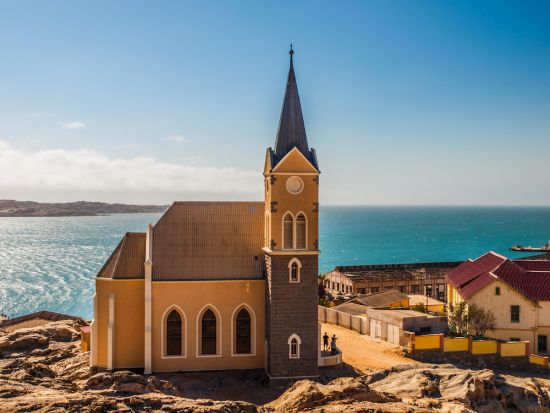
The object was a diamond, and as the local population soared, grand houses were built, train tracks spread along the coastline and an entire mining town grew out of the desert.
Fortunes were indeed made, but the diamond rush was brief, lasting barely a decade. Fast forward almost 150 years and little remains of the extreme wealth the town once enjoyed.
Instead, today’s Lüderitz makes an intriguing port call, rich in history, architecture, wildlife and breathtaking scenery, nestled on a dazzling coastline of clear, deep blue waters.
What to see in Lüderitz
Unlike other cruise ports in southern Africa, Lüderitz has just a handful of must-see sites, so it’s easy to tick them off in a single day.
The town is littered with colourful German art deco buildings with bold red roofs and pastel-pink walls, so simply wandering its dusty streets is a feast for the eyes.
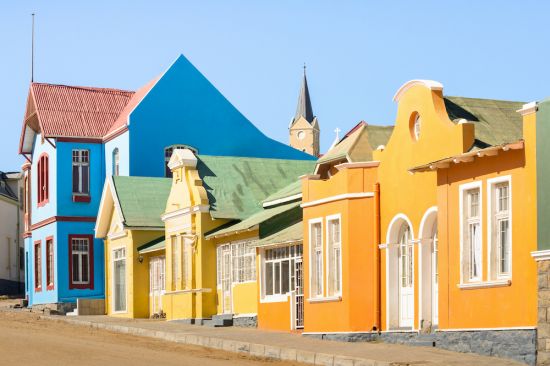
One of the most prominent landmarks is the Felsenkirche – literally ‘church on the rocks’ – built in 1911 in the Victorian gothic style, and now a national monument. But perhaps Lüderitz’s most impressive sight is the Goerke Haus.
Cut into the cliffs of Diamond Hill, overlooking the bay, this grand art nouveau home is one of the striking reminders of the mining town’s former wealth. Built in 1910 as the home of Lieutenant Hans Goerke, it is well worth a visit, with its vaulted ceilings, carved pillars, antique furnishings and stained-glass flamingo windows.
If wandering through these grand rooms, filled with sepia photographs, leaves you hungry for more of the town’s fascinating history, head to the Lüderitz Museum. Here you can discover more about the diamond industry and local wildlife, and learn of the indigenous Herero and Nama tribes who perished in a German concentration camp on nearby Shark Island.
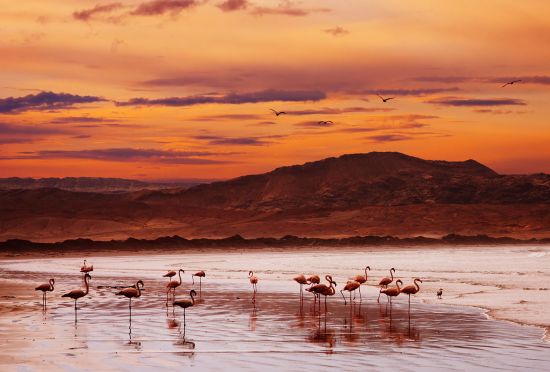
Anything from antelope skeletons to tribal weaponry can be found on the museum’s shelves – but like everything in this quirky little town, its opening hours are changeable, so it’s a good idea to call ahead and book a time.
Stepping back on to the sandy streets, it’s easy to see why this coastline is so inhospitable to humans. The local waters, however, are teeming with wildlife. Whales, seals and dolphins all frolic in the crisp, clear water, feeding on an abundance of oysters, rock lobsters and mussels, and they can easily be spotted from the sun-bleached cliffs.
While the local seafood is exported all around the world and sold for sky-high prices, some of it lands in the kitchens of Lüderitz’s cafes. For fresh crayfish and Namibian oysters, head to Diaz Coffee Shop, or taste Portugal’s influence on southern Africa at the Portuguese Fisherman.
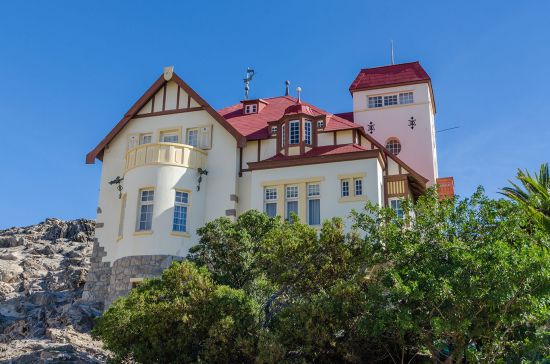
But on the weekend, nowhere buzzes like Barrels, a German restaurant and beer garden where locals dine on hearty dishes like beef goulash and sauerkraut.
Quirky Kolmanskop
Many cruise ships don’t spend long in Lüderitz, but there is one site that shouldn’t be missed – the ghost town of Kolmanskop. Standing like a mirage in the swirling sandstorms, this was once a bustling hub for diamond workers and their families. But when better diamond deposits were found across the Orange River, its residents packed their bags, leaving the town and many of their belongings to be reclaimed by the Namib.
Kolmanskop is just a six-mile drive into the windswept hinterland from Lüderitz, and today – with a permit – visitors can freely wander and photograph its crumbling mansions.
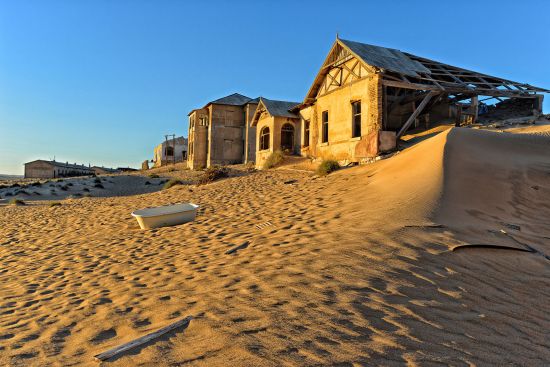
Many are almost up to their ceilings in sand, with scraps of wallpaper fluttering in the wind, chipped Italian marble glinting in the sun, and their ornately carved doorways leading to nothing but desert.
Not only did the town house miners and their families, but it had shops, a bowling alley and a community hall. You’ll even find the remains of a vast swimming pool, dried up by decades of blistering heat.
There was also a hospital, equipped with the first X-ray machine in the southern hemisphere. Still standing, this is sometimes used as a backdrop for fashion shoots or the occasional post-apocalyptic Hollywood film. And no wonder, because an undeniably haunting feeling grips you as you walk through its narrow wards today.
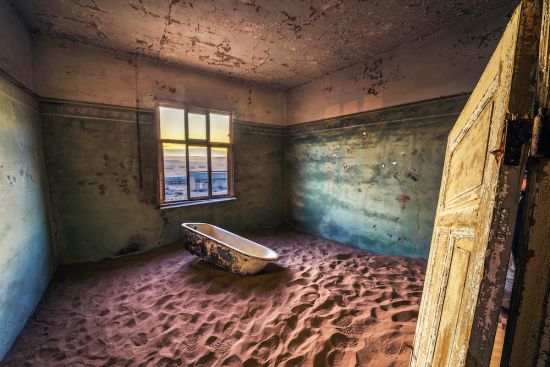
However you spend your time in Lüderitz, you’ll experience this feeling of pure isolation. In fact, there are few places on earth that seem so far away from day-to-day life as this tiny speck of civilisation on the Skeleton Coast.
As you sail away, look back on the view that thousands of Germans saw when they came to make their fortunes more than a century ago. Inhospitable, perhaps, but an incredible destination for any truly inquisitive traveller.
In the Know
Entry requirements
No visa is required for UK citizens, but your passport should be valid for a minimum of six months from the date of entry into Namibia, and have at least one completely blank page for immigration.
When to go
The best time to see Lüderitz is from November to May, but temperatures are pleasant all year round. It’s also worth visiting during the annual Lüderitz Crayfish Festival, held in April/May each year.
Luderitz travel tips
- In Lüderitz, Namibian dollars and South African rands are accepted. They have the same value, and the Namibian dollar fluctuates as the rand does.
- The town gets very windy, and those visiting Kolmanskop should bring protective clothing or a scarf.
- Check times of museums and attractions – some open for just one hour a day.
- Make sure to get a permit before exploring nearby Kolmanskop. Permits can be purchased at the gates of the protected site.
Get on board
Azamara 21-night ‘Western Africa Voyage’ cruise aboard Azamara Pursuit, from Lisbon to Cape Town via Gran Canaria, Banjul and Lüderitz, departing on 30 November 2021, from £5,509. azamara.co.uk
Regent Seven Seas 16-night ‘South African Radiance’ cruise aboard Seven Seas Voyager, roundtrip from Cape Town via Lüderitz, departing 21 November 2021, from £9,329. rssc.com
